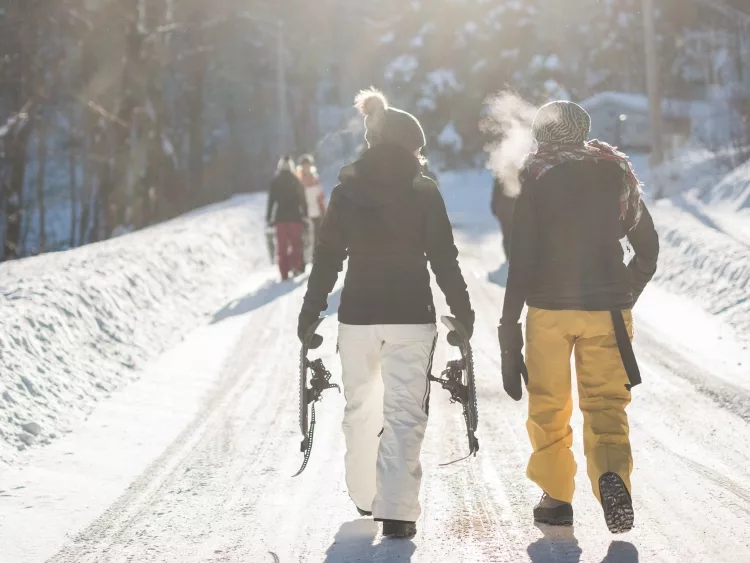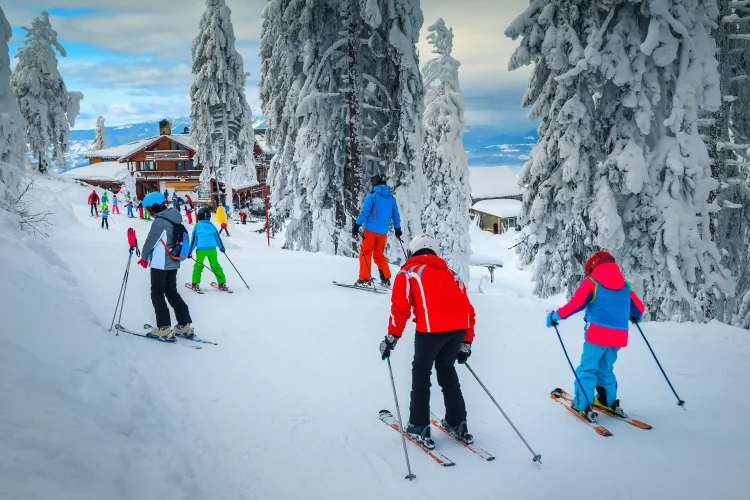Which Mistakes Should a Beginner Avoid When Skiing for the First Time?
by Frank V. Persall
Last winter it snowed more and a friend of mine thought that it was the best time to start his skiing expedition. He was not a complete beginner but had little experience in his hands and took a daring decision to take his family with him as well. We all expected this holiday to be awesome but when he returned he looked horrified and had terrible tales to tell. So what made his ski trip so awful?
Contents
Which mistakes should a beginner avoid when skiing for the first time?
Was he less prepared or was he overconfident about his skiing skills or did he commit many mistakes that could have been easily avoided?
Actually, the answer is a combination of all these reasons. While they managed to have a good time in the end and the kids managed to smile in the end, their trip suffered a lack of planning and preparation to be precise. Expecting this winter to be freezing cold we both had a long discussion and managed to write down a list of "do's" and "do not's" for the skiers especially those who are beginners or skiing for the first time.

1. Drink gallons of water!
Your throats run dry on higher altitudes and dehydration due to extreme cold can be very inconvenient too. Therefore, it is always advisable to drink enough water to suffice your H2O needs during the ski rides. Many people make the mistake of not drinking water as they think that the thirst factor will hit them only in the hot and humid climate. They are wrong and as beginners, they are expected to start skiing without water in their stomach but it will soon get uneasy as the icy winds will freeze them and they will gasp for water.
2. Don't forget to pee!
Now that you had plenty of water it is time to wear your ski gear. However, do not rush in as yet as it takes time to wear a ski gear and once you wear them it is no returning back. Therefore, you should check if your stomach feels ok or you have to empty your bowels clean before hopping in the ride. Being comfortable is the most essential thing while skiing and therefore it is better to be light and fresh before every ski ride. Also, do not forget to pee since there would be no bathrooms made for you on the top.
3. Too tight boots!
Most of the ski boots have buckle straps and in the freezing cold weather, we often lose the sensations of our feet. Therefore, it is recommended for the beginners to check the fitting of their ski boots before starting any ski ride.
To do not wear them too lose or you will risk your safety and do not clasp them too tight or you will end up hurting yourself after the ski ride. Also, check the insides of your ski boots and scrape out any dirt accumulated in it so that the fine dirt particles do not hurt you upstairs. Some people especially the beginners tend to faster their shoe buckles and straps too tight because they feel that it will provide them with more security.
However, it is a grave mistake which they might not realize earlier but it will hurt them when they reach home or in a more cozy and warmer place. Using socks which are specially made for wearing with ski boots is also a good idea as they keep your feet warm and clean. They will also provide you comfort even if you have worn your ski boots in a tight way. Ski socks also protect your feet from blisters which is a great thing especially when you do not have to deal with sore feet at the end of the day.
4. "Hungry" ski rides
Ski rides are meant to be done when your stomach is light but it does not mean that you have to starve yourself to death. We have often heard people complaining and wincing from hunger as they reach the top as the colder climate tends to fuel your hunger.
Therefore, eat your food but do not overdo it and do not forget to carry a pack of chips or biscuits along with tiny water bottles in your ski boot bag. All these things do not seem to be that important but even the strongest of people cannot bear hunger and therefore it is always better to go prepared for a ski ride.
5. Skipping helmets
Not wearing a helmet is as dangerous during ski rides as it is while riding bikes (although these helmets are entirely different). Some people do not feel comfortable in helmets but they do not realize that it is essential for their safety and they cannot compromise it at any cost. Some beginners may ask, can they wear wool caps.
They can wear but wool caps will not provide them the safety that a helmet will provide even they might feel more comfortable in it. There have been near fatal accidents during ski rides where the severe head injuries could have been avoided if the skier had a helmet. Therefore, we advise the beginners to wear helmets especially when the skiing on rocky snow mountains.
6. Wearing too many clothes

Few individuals might think that they need to wear as many clothes as they can before a ski ride. It might make some sense in the evening and during the wee hours of the morning but it is certainly not necessary to wear your ski gear on your regular clothes. Use fleece jackets, scarves and gloves instead which will keep you warm at all costs. Wear an extra t-shirt in if you cannot endure cold weather and even that is not necessary if you are skiing in the afternoon.
Also, wearing the clothes made from the right fabric is as crucial as well. Beginners tend to wear usually cotton and jeans but these are not the recommended type of fabrics you should wear during your skiing expedition especially if it is your first trip. As a beginner, you will not be used to skiing smoothly and will tend to fall many times before mastering the skill.
Wearing jeans and apparels made of cotton is not a great choice because they absorb the moisture from the snow quickly when you wall and tend to get wet. Moreover, they do not dry quickly and make you feel uncomfortable all during your ski ride. We advise you to wear clothes that have moisture wicking ability and such clothes are usually made from polyester or silk. Clothes made from wool are also a good option as they dry quickly and also keep you warm during your ski trip.
7. Not wearing sunscreen
Not wearing sunscreen is a common mistake most skiers make and the beginners do tend to absolutely forget about it as they feel that the weather is nice and cold upstairs. The weather remains cold at the mountain slopes for sure but that does not mean that sun stops sending its rays. Even if the climate is cloudy there will be enough UV rays penetrating through them directly on your skin and so it is better to protect your face at all times. It will also protect your skin from the harsh winds as well and you will not feel sorry for your skin after a rough ski ride.
8. Skiing without training
Skiing without proper training for the instructor can prove to be a grave mistake especially when you are a beginner. There are many instructional videos on the YouTube and internet which tell how to get prepared and how to practice things before actually hitting the snow.
There are different aspects and elements that decide your experience and you can focus on them only if you have a proper idea. Do not take training from your friend or lover even if they are experienced skiers because they are not experienced in providing training and that can make a great difference. How to apply breaks, how to cut corners, how to speed, how to slow, how to approach a slope and much more things are to be learned and that practicing the basics with a proper trainer can prove to be the difference maker.
We advise you to learn the basics first and then graduate slowly to become a pro. Do not hurry things or else you will end up hurting yourself. It is always better to learn things from an instructor who has himself/herself been an experienced skier with a good reputation as well.
Nowadays the hotels and hill resorts you stay in also have their own trainers but sometimes they are not so professional in their approach. Therefore, it is better to hire a trainer especially when you are planning to ski with a group. When you are skiing with kids do not get impatient as they tend to learn cautiously. Give them their space and time and they will learn to ski before your expedition ends.
Not checking the weather and conditions It is better to check the weather and conditions before skiing especially for the beginners because they need to learn the art of skiing in a secure environment and comfortable space. Also, there must be ample of snow so that even if you fall it will not hurt your butt. Skiing in rough weather is a true adventure but that is only for the experienced skiers who know how to survive when there is an avalanche.
Beginners should only ski in secure weather conditions and they must confirm it before getting out from their home itself. Beginners tend to overlook these crucial aspects and often end up spoiling their trips. Not all snowy mountain slopes and patches are safe at all times and therefore you must ski on the easiest and simplest of the tracks especially if you are a beginner.
9. Arriving late
An experienced skier knows that the best time to ski is in the morning when there aren't many skiers around. It not only gives you a feel of the mountain slopes but it also helps you to get more comfortable with the surroundings and especially the snow! Beginners tend to get a bit nervous when there are many experienced skiers are around so it is always preferable to ski when no one is skiing around and flaunting his or her skills.
Also, the snow tends to lose its texture and softness as too many skiers use the tracks and therefore arriving early in the morning and being the first one to descend the mountain slopes is always a great idea. Many beginners miss this trick and end up getting late in the morning. Therefore, then arrive late in the morning or even in the afternoon when the snow is already getting hard and beginners will find very hard to practice in such conditions.
10. Not wearing goggles
Visibility is a key factor when you are skiing as blurred visions can result in accidents and collisions with fellow skiers. Beginners tend to forget this and this can prove to be a crucial mistake that could spoil your skiing experience totally. Also, sunglasses are not an option to skiing goggles at any cost. Sunglasses are usually tanned and tend to affect your vision significantly while skiing.
Also, when the winds are blowing it is not a smart idea to wear sunglasses as they will come off easily and you will be left with no option. Skiing goggles have a protective construction and they are designed to fit your head perfectly. As a result, they do not come off even when lusty winds blow and your eyes remain safe and clear while skiing.
Conclusion
These were some of the common mistakes the beginners make while skiing apart from getting impatient and nasty. If you wish to not be amongst those dreadful first-timers, learn and practice well before skiing and follow all the instructions of your trainer. Also, do not forget to follow the precautions we have mentioned above and enjoy a safe and eventful skiing!Related Posts:
How Warm Is To Warm For Skiing
 |
 |
 |
 |

About Frank V. Persall
Frank is originally from the UK, but he has a passion for skiing that knows no bounds. He has made it his life's mission to visit the best ski resorts across the USA and the World. Frank loves spending time with his wife and three children on ski slopes, as they all share his love for the activity.
Thoughts on "Which Mistakes Should a Beginner Avoid When Skiing for the First Time?"
 |
 |
 |
 |
You can get FREE Gifts. Or latest free skiing books here.
Disable Ad block to reveal all the info. Once done, hit a button below
 |
 |
 |
 |